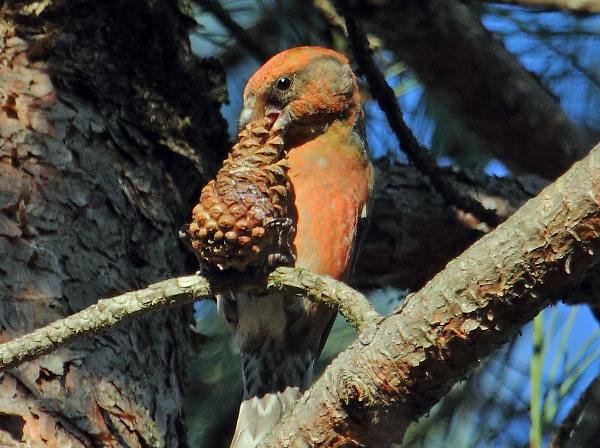Loxia curvirostra - Common Crossbill
Phylum: Chordata - Class: Aves - Order: Passeriformes - Family: Fringillidae
Identification - Distribution - Lifecycle - Food - Predators - Reference Sources

Above: a male Crossbill
Identification
Also referred to as Red Crossbills, these are plump birds typically 17cm in length and with a wingspan of about 29cm. They have chunky heads with strange crossed bills - a clear identification feature because no other British bird has this characteristic - with which they extract seeds from the cones of coniferous trees, particularly pines. Their legs and forked tails are relatively short. The males have reddish-orange plumage, whereas the females are greenish-yellow. The alarm call of the Common Crossbill is a distinctive 'chip-chip-chip', while the male's song is a soft twittering sequence of short trills.
Distribution
In Britain this lovely member of the finch family breeds in the Scottish Highlands, on the North Norfolk coast, in Breckland, in the New Forest and in the Forest of Dean; they are rarely seen in central England, Wales and the westcountry, however. Elsewhere this species is found throughout most of central and northern Europe and Asia, and in North America.
Food
Crossbills feed mainly on the seeds concealed within pine cones and the cones of other conifers.
Predators
Being conspicuous when contrasted against a mainly green background, Crossbills are vulnerable to avian predators such as corvids (such as Magpies) and raptors (for example Sparrowhawks); however, occasionally Britain's resident populations are transiently enhanced by influxes (irruptions) of birds from continental Europe.
Lifecycle
Crossbills make their nests in conifer trees. Because pine seeds are plentiful very early in the year, Crossbills often hatch their chicks as early a February and March, but they have been known to breed in spring, summer, autumn or winter, producing three to five pale blue-green eggs that are speckled with brown. The female incubates the eggs for 12 to 16 days, Initially, the chicks do not have crossed bills; this feature appears after about five weeks, at which point the parents stop feeding them because the young birds are able to feed themselves, extracting seeds from pine cones.
Conservation Status
In the UK, the Common Crossbill is classified as 'Green' under the Birds of Conservation Concern 4: the Red List for Birds (2015). It is protected under the Wildlife and Countryside Act (1981).
Reference Sources
Clive Viney & Ray Tipper (2nd Edn., 2016) Algarve Wildlife, the natural year, First Nature
BTO News Release Are predators to blame for songbird declines? 2010-03-10
Acknowledgements
This page includes pictures kindly contributed by Will Bown.
Please Help Us: If you have found this information interesting and useful, please consider helping to keep First Nature online by making a small donation towards the web hosting and internet costs.
Any donations over and above the essential running costs will help support the conservation work of Plantlife, the Rivers Trust and charitable botanic gardens - as do author royalties and publisher proceeds from books by Pat and Sue.

